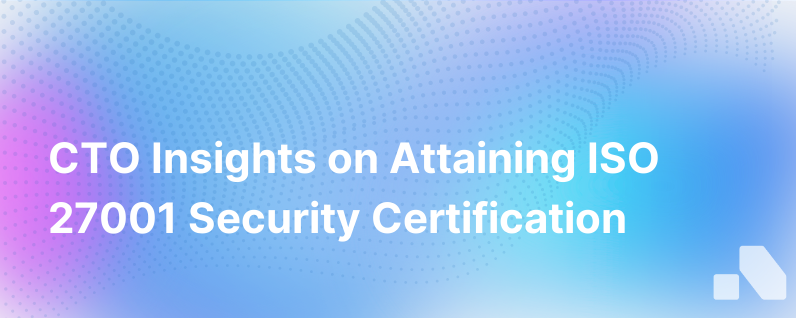A Ctos View Of The Journey To Iso 27001 Security Certification
Published on October 28, 2023 by Sawyer Middeleer
In the technologically advanced era we thrive in today, data is the lifeblood of any organization. This data, however, is continually under threat from hackers, breaches, and various forms of cyber-attacks. In such a climate, securing company and customer data becomes paramount, and ISO 27001 emerges, not merely as a certification but a necessity.
As a Chief Technology Officer (CTO), leading my organization on the journey to ISO 27001 security certification is equivalent to steering the ship through rough waters into the tranquility of a protected harbor. It’s a transformative journey that permeates every layer of the organization, stretching from the technological heart to the outermost skin of processes and policies.
ISO 27001 is an internationally recognized standard that provides a framework for an information security management system (ISMS). It assures stakeholders that the risk to information assets is being managed responsibly. It also demonstrates a commitment to continuous improvement, which is vital in the fast-evolving cyber-threat landscape.
Let’s break down the journey to achieve this coveted standard from my perspective.
Understanding the Scope
As a CTO, my first objective in leading the ISO 27001 journey was understanding the scope of the ISMS. This standard isn't just about what software or hardware you use; it's about how you manage information security in all its forms. That includes physical security, access controls, policy implementation, staff training, and compliance with legal and contractual obligations.
It was essential to ensure that every employee understood that ISO 27001 isn't a one-off project with a defined end but a continuous, evolving strategy that integrates into the DNA of our business operations.
Top-Down Commitment and Culture Change
To embark on this journey, it was critical to have commitment from the top down. ISO 27001 certification demands a cultural change and constant vigilance. When the leadership team embodies the importance of security, it trickles down, permeating all levels of the organization.
Spearheading a cultural shift meant reevaluating our values and practices around security and demonstrating through actions and policies that information security is not just an IT concern but a fundamental company priority.
Risk Assessment and Treatment
One of the core facets of ISO 27001 certification is conducting a thorough risk assessment. In my role, I led the charge in identifying where our sensitive information resides, how it flows within and outside of our organization, and the various risks it faces in its lifecycle.
Crafting a risk treatment plan was the subsequent step, which involved selecting appropriate controls from the ISO 27001 standard, applying them, and then tracking whether or not our risk appetite was sufficiently met.
Strengthening the Framework
Developing and implementing robust security policies and procedures was an integral piece of the puzzle. In my capacity, I ensured that these policies were not just words on paper but were enforced and followed. We installed safeguards at every point from security patches and firewalls to ensure physical security of our data centers.
A significant aspect of strengthening our framework was involving our employees. Regular training sessions were held, and security practices were ingrained within our day-to-day work flow.
Continuous Monitoring and Improvement
Setting up the framework for ISO 27001 is one thing, but maintaining it is another. It’s an ongoing process that requires regular reviews, including internal audits, continual monitoring, and improvement of the ISMS.
In measuring the effectiveness of our ISMS, I closely tracked metrics and key performance indicators that aligned with our information security objectives. This helped provide insights into the areas that needed refinement and those that performed well, paving the path for ongoing improvement.
External Auditing
After rigorous internal evaluations, the next step was to undergo an external audit performed by an accredited certification body. This stage was critical, as it provided an independent validation of our ISMS.
Preparing for this external audit involved meticulous documentation of our processes and ensuring evidence was on hand to demonstrate our compliance.
Overcoming Challenges
The journey was not without its challenges. There were technological, people, and process-related hurdles to overcome. Adapting to new technologies to guard against the latest threats while maintaining the balance between security and operational efficiency was a delicate dance.
Engaging the team in the required changes to how they worked on a day-to-day basis and ensuring everyone knew the role they played in maintaining our ISMS was equally demanding.
Achieving Certification
Upon passing the external audit, the organization was awarded the ISO 27001 certification, a testament to the rigorous standards we adhered to for information security.
However, achieving certification was just a milestone; maintaining it is the ongoing journey. As a CTO, I am constantly looking towards the horizon, staying abreast of the latest threats and incorporating best practices to not only keep our ISMS certification relevant and effective but also to embed these practices into the core operations of the business.
Conclusion
The journey to ISO 27001 certification is a marathon, not a sprint. It has transformed how we approach data security and has made it a central part of our corporate identity. Customers, partners, and other stakeholders now have greater confidence in our ability to safeguard their data.
For any organization looking to traverse this path, I would suggest keeping an eye on the ultimate reward: robust security practices that protect your company’s and customers’ information, thereby fostering trust, a pillar of any successful B2B relationship.
It is through this lens that my role as a CTO has evolved. No longer solely focused on technological innovation, I am now the steward of trust, leading a ship that’s not only fueled by its tech prowess but also shrouded in the armor of world-class security standards.